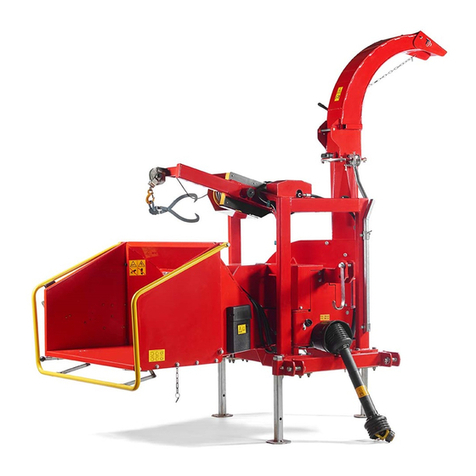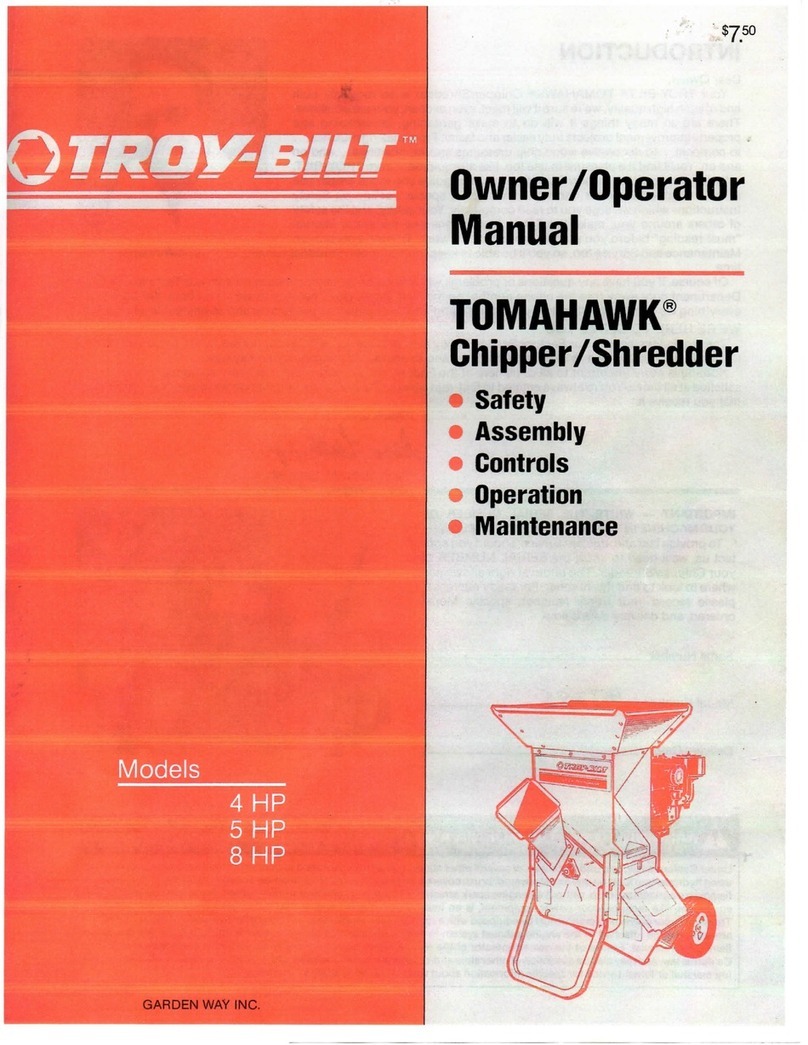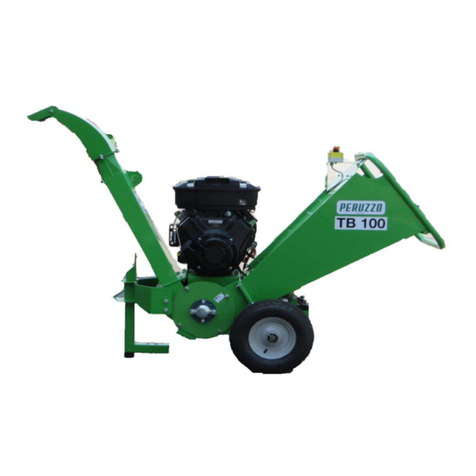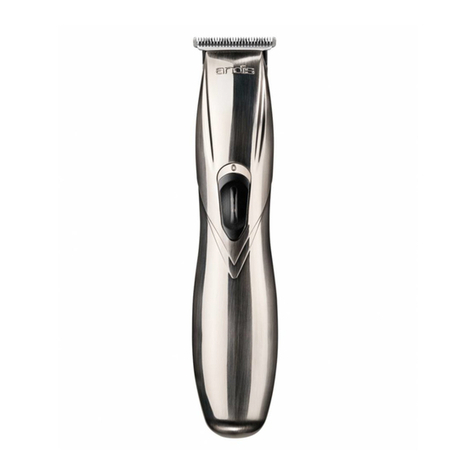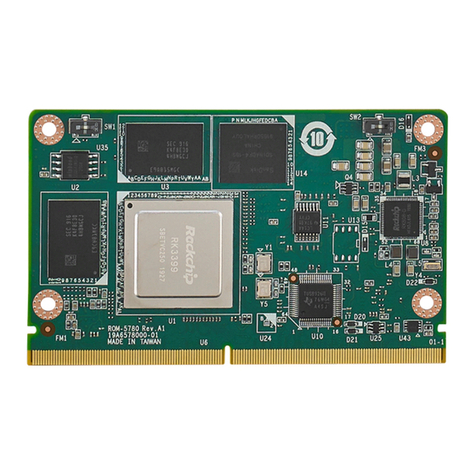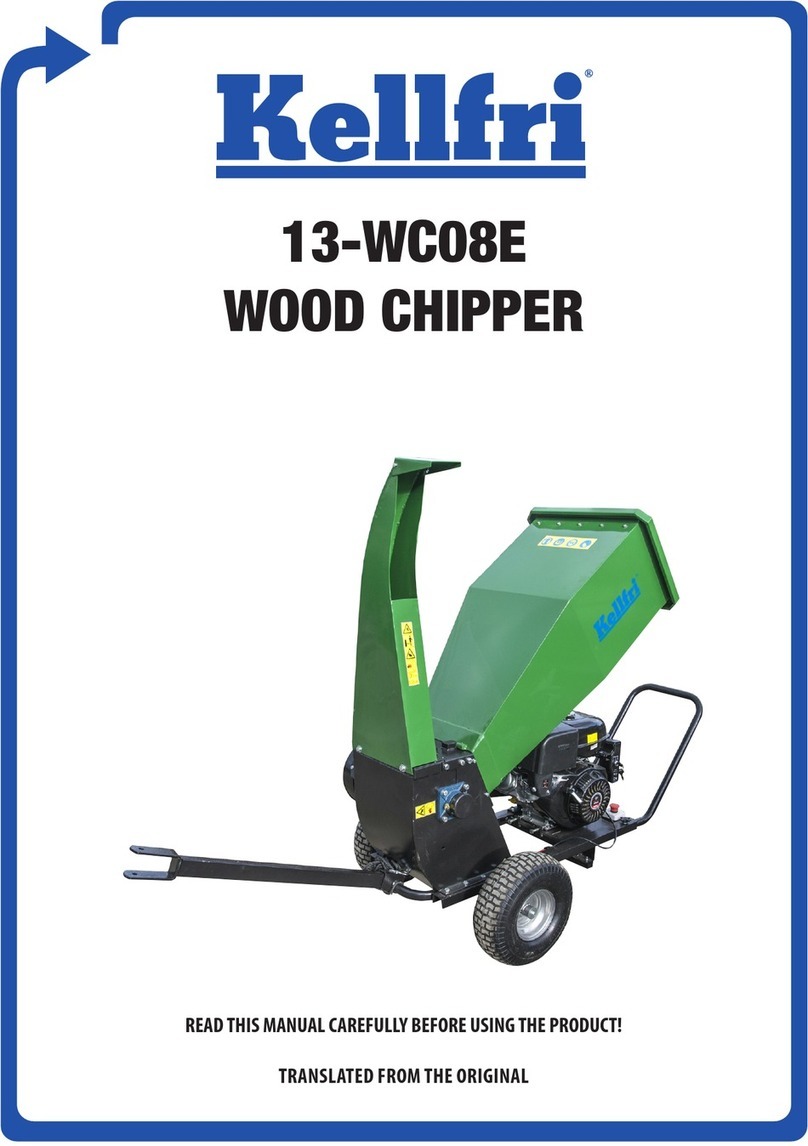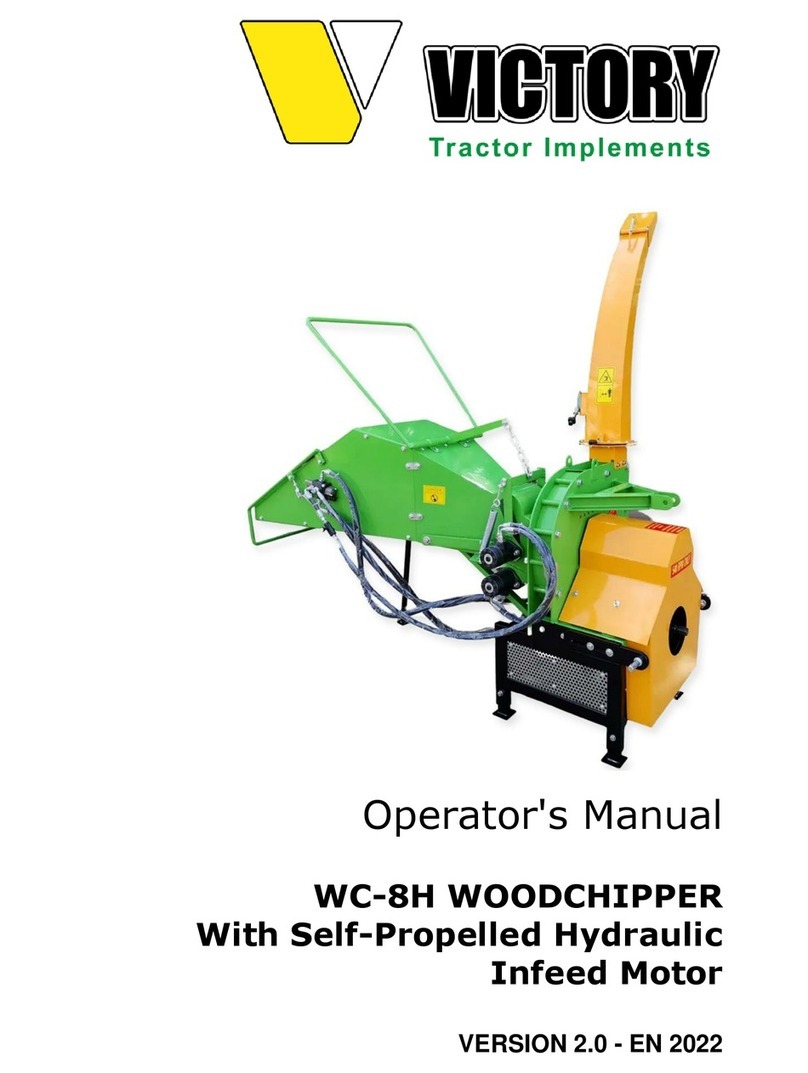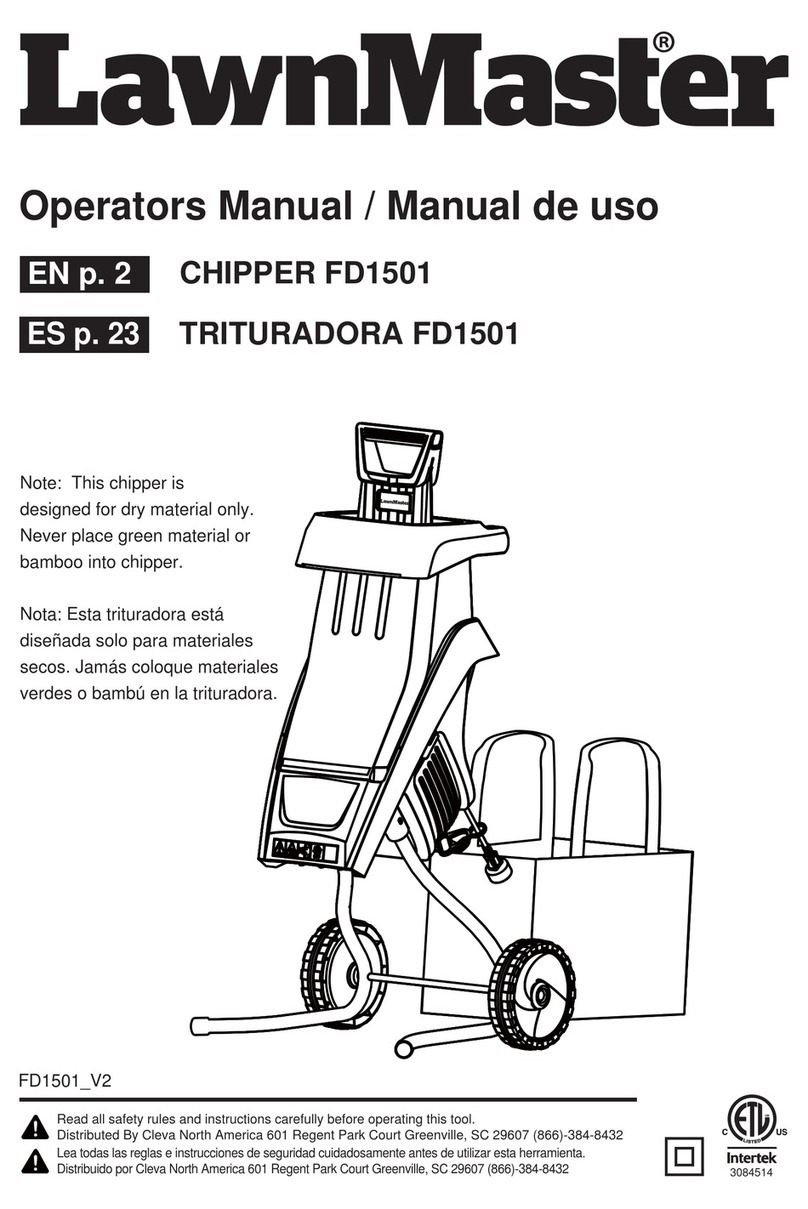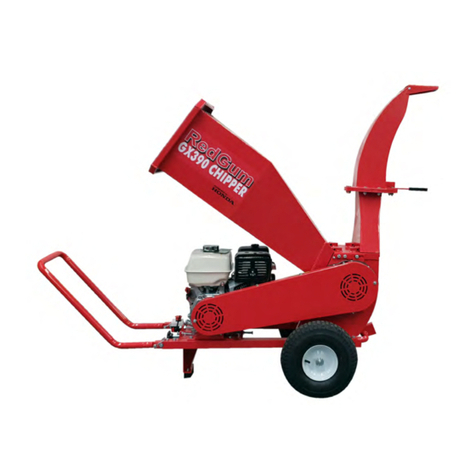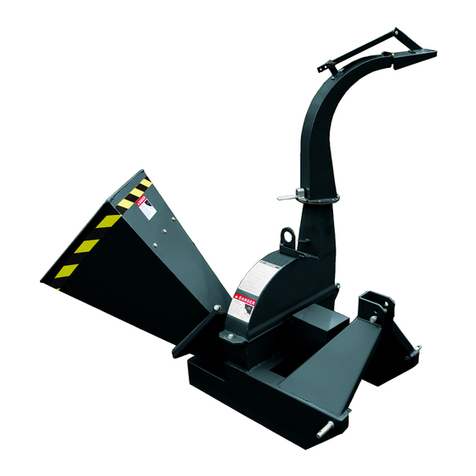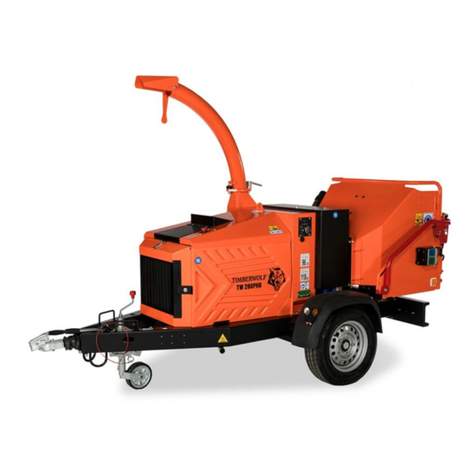Cleco CL Series Installation and operating instructions

1
Operation & Service Manual
823057 2/00
CL SERIES CHIPPERS
Round
Hexagon
RD
HX
CL
Stroke:
Nose Type :
33"
Series:
Standard for CL Models OnlyL
Retainer :
CL --
-
3XXL
NORTH AMERICA EUROPE
P.O. Box 1410
Lexington, SC 29071 Postfach 30
D-73461 Westhausen

2
throttle moves freely and returns to closed position). Being
carefulnottoendangeradjacentpersonnel,cleartheairhose
of accumulated dust and moisture. Attachment of a quick-
disconnect air coupling directly to the inlet threads of a
percussion tool can cause wear and failure of the coupling.
Should the coupling fail, severe injury can result from the
hose end violently whipping about. If a quick-disconnect air
coupling is used, separate the coupling from the tool with a
whip hose (1.5 feet minimum). Only use a whip hose with
fittings of hardened steel or other material which is at least
comparablyresistantto shock.Donot usehoseto liftorlower
tool.
Cracked chisels or implements are
hazardous. Visually inspect the chisel
orimplementforcracksbeforeuse.Makeapracticeofhaving
all chisels magnifluxed before resharpening. Destroy and
discard any chisel or implement that shows a crack.
Correct selection of the chisel or other implement is impor-
tant. Dull edges on the chisel or moil point cause the energy
of the percussion blow to be absorbed by the tool itself,
instead of the workpiece, increasing the chance of chisel
breakage. When operating percussion tools in explosive or
flammable environments, use only non-sparking chisels or
implementssuchasthosemade fromberylliumcopper.Also,
do not use cupped rivet sets with Cleco percussion tools to
drive nails. Blows not centered on the nail can cause the nail
to ricochet off the work and strike the user.
Before removing a tool from service, after completing a job,
orchangingchiselsorotherbits,make suretheairlineisshut
offand drainedofair. Thiswill preventthetool fromoperating
Safety Recommendations
Foryoursafetyandthe safetyofothers,readand understand
the safety recommendations before operating any percus-
sion tool.
Always wear protective equipment and clothing.
For additional information on eye protection, refer to Federal
OSHA Regulations, 29 CFR, Section 1910.133, Eye and
Face Protection, and ANSI Z87.1, Occupational and Educa-
tional Eye and Face Protection. This standard is available
fromtheAmericanNationalStandardsInstitute,Inc.,11West
42nd Street, New York, NY 10036.
Hearing protection is recommended in high noise areas
(above85 dBA). Closeproximity ofadditionaltools, reflective
surfaces, process noises, and resonant structures can sub-
stantially contribute to the sound level experienced by the
operator. For additional information on hearing protection,
refertoFederalOSHARegulations,29CFR,Section1910.95,
Occupational Noise Exposure, and American National Stan-
dards Institute, ANSI S12.6, Hearing Protectors.
Gloves and other protective clothing should be worn as
required.Properlyfitted glovescushionvibration andprotect
the fingers from pinching, scuffing and scraping and must be
used when guiding the chisel on a workpiece.
Cleco percussion tools are designed to operate on 90 psig
(6.2 bar) maximum air pressure. Excessive air pressure can
damage the plunger and increases sound levels. Installation
ofafilter-regulator-lubricatorintheairsupplylineaheadofthe
tool is highly recommended. Before the tool is connected to
the air supply, check the throttle for proper operation (i.e.,
WARNING
!
WARNING!
Explosive Hazard.
Use only nonsparking chisels or
implements in explosive or
flammable environments.
Impact Hazard. Ejected chisels can cause
serious injury or even death.
Disconnect air before changing chisels.
Do not operate unless chisel is in contact
with workpiece.
Do not point tool in direction of any person.
Use safety retainers on tool and retainer
type chisels.
WARNING!
Erect barriers to protect persons in
surrounding or lower work areas.
WARNING!
Impact resistant eye protection
must be worn while operating
or working near this tool.
CAUTION!
Personal hearing protection is
recommended when operating
or working near this tool.
WARNING!
Compressed air hazard.
Compressed air can cause loss
of eyesight, bleeding or injection
of foreign material into the body
or blood.
Never use compressed air to clean
off clothing or direct it at any person.
Quick Disconnect Coupling Quick Disconnect Coupling
Do not use! OK
Coupling Nipple Whip Hose
Coupling Nipple

3
cold and dampness, diet, smoking and work practices are
thought to contribute to the conditions. Any user suffering
prolonged symptoms of tingling, numbness, blanching of
fingers, clumsiness or weakened grip, nocturnal pain in the
hand, or any other disorder of the shoulders, arms, wrists, or
fingers is advised to consult a physician. If it is determined
that the symptoms are job related or aggravated by move-
ments and postures dictated by the job design, it may be
necessary for the employer to take steps to prevent further
occurrences. These steps might include, but are not limited
to, repositioning the workpiece or redesigning the worksta-
tion, reassigning workers to other jobs, rotating jobs, chang-
ing work pace, and/or changing the type of tool used so as to
minimize stress on the operator. Some tasks may require
more than one type of tool to obtain the optimum operator/
tool/task relationship.
• Tasks should be performed in such a manner
that the wrists are maintained in a neutral
position, which is not flexed, hyperextended,
or turned side to side.
• Stressful postures should be avoided. Select
a tool appropriate for the job and work
location.
Work gloves with vibration reducing liners and wrist supports
are available from some manufacturers of industrial work
gloves. Tool wraps and grips are also available from a
numberofdifferentmanufacturers.Thesegloves,wraps,and
wrist supports are designed to reduce and moderate the
effects of extended vibration exposure and repetitive wrist
trauma.Since theyvarywidely indesign, material,thickness,
vibration reduction, and wrist support qualities, it is recom-
mended that the glove, tool wrap, or wrist support manufac-
turer be consulted for items designed for your specific appli-
cation. Proper fit of gloves is important. Improperly fitted
gloves may restrict blood flow to the fingers and can
substantially reduce grip strength.
This information is a compilation of general safety practices
obtained from various sources available at the date of pro-
duction. However, our company does not represent that
everyacceptablesafety practice isconsideredherein, or that
abnormal or unusual circumstances may not warrant or
require additional procedures. Your work may require addi-
tionalspecificsafetyprocedures.Followtheseproceduresas
required by your company. For more information, see the
latest edition of ANSI B186.1, Safety Code for Portable Air
Tools, available from the American National Standards Insti-
tute, Inc., 11 West 42nd Street, New York, NY 10036.
if the throttle is accidently engaged. Use of a self-relieving
valve within reach of the user of the tool is highly recom-
mended.
Do not operate or trigger any percussion tool unless the
chisel, scaling tool, rivet set, or other implement is in the tool
andincontactwiththeworkpieceorworksurface.Neverpoint
any percussion tool in the direction of another person or
yourself, or deliberately eject a chisel. Failure to do so can
cause serious injury and/or damage the tool.
Chisel or rivet set retainers are recommended and furnished
asstandard equipment.Periodic inspection of the retainer
forwearordamageisrecommendedsincethesedevices
can receive heavy abuse, particularly if the tool is run off
the workpiece. Damaged retainers are dangerous, and
can allow the ejection of a chisel or other implement.
They must be replaced as necessary. Only use safety
retainer type chisels, as shown in the operating instruc-
tions and service manual. Also, it is good safety practice to
erect suitable barriers to protect persons in surrounding or
lower work areas from possible ejected tools.
Some individuals
may be suscep-
tible to disorders
of the hands and
arms when per-
forming tasks
consisting of
highly repetitive
motions and/or
exposure to ex-
tended vibration.
Cumulative
trauma disorders such as carpal tunnel syndrome and ten-
donitis may be caused or aggravated by repetitious, forceful
exertions of the hands and arms. Vibration may contribute to
a condition called Raynaud’s Syndrome. These disorders
developgraduallyover periods of weeks,months, and years.
It is presently unknown to what extent exposure to vibrations
or repetitive motions may contribute to the disorders. Heredi-
tary factors, vasculatory or circulatory problems, exposure to
Safety Recommendations
Repetitive work motions and/or vibration
may cause injury to hands and arms.
Use minimum hand grip force.
Keep body and hands warm and dry.
Avoid anything that inhibits blood circulation.
Avoid continuous vibration exposure.
Keep wrists straight.
Avoid repeated bending of wrists and hands.
WARNING!
BAD POSTURE
GOOD POSTURE
0
90
45
Self-Relieving
Valve
Filter
Regulator Lubricator
Tool
Hose
Coupling
INDIVIDUAL WORK STATION
Quick Disconnect
Coupling

4
The Cleco "CL" series chipper is designed to
operateon90psigairpressureusinga3/8"I.D.
hose up to 8' in length. If additional length is
required, a 1/2" I.D. or large hose should be
connected to the 3/8" hose.
Theairhoseshouldbeclearedofaccumulated
dirtandmoisture,thenone-half(1/2)teaspoon
of 10W machine oil should be poured into the
tool'sairinletbeforeconnectingthehosetothe
tool.
Important: Check handle and barrel engage-
mentafterthefirsteighthoursofoperation,and
weekly thereafter. Failure to do so may cause
damage to the assembly.
LUBRICATION
An automatic in-line filter-lubricator is recom-
mended as it increases tool life and keeps the
toolin sustainedoperation. Thein-line lubrica-
tor should be regularly checked and filled with
agoodgrade of10W machineoil.Never usea
heavyoil,asthis willcausealossof efficiency.
Proper adjustment of the in-line lubricator is
performed by placing a sheet of paper next to
theexhaustportsandholdingthethrottleopen
forapproximately30seconds.Thelubricatoris
properlysetwhen alight stainofoil collectson
the paper. Excessive amounts of oil should be
avoided.
If the operation of the chipper becomes slug-
gish or erratic, pour one teaspoon of solvent
into the air inlet and operate the tool for a few
seconds.Lubricatethetoolasexplainedabove
after flushing.
Eye protection must be worn when disassembling tool or when air line is
turnedon. A self-relievingvalve inclose proximityto therepair stationto
bleed off air is recommended.
INSTALL RETAINER WITH
CHISEL ONTO BARREL WHILE
ALIGNING SLOT IN RETAINER
WITH GROOVE ON BARREL.
INSERT CHISEL INTO
RETAINER AND ROTATE
RETAINER 1/4 TURN
(90°) IN EITHER DIRECTION.
INSERT SPRING INTO SLOT
IN RETAINER UNTIL ONLY
TAB ON SPRING IS EXPOSED.
TAB
LOCK SPRING
BARREL
RETAINER
CHISEL
STANDARD RETAINER
GROOVE
SLOT
OPERATING INSTRUCTIONS
STORAGE
Intheeventthatitbecomesnecessarytostorethe
tool for an extended period of time (overnight,
weekend, etc.), it should receive a generous
almountoflubrication atthat timeand againwhen
returned to service. Store the tool in a clean and
dry environment. Alternatively, chippers and scal-
ers may be put in a bucket of solvent or light oil for
extendedperiods ofstoragesuch asweekendsor
plant shutdowns. The tool should always be lubri-
cated before storage and when being returned to
service.
CHISEL INSTALLATION & REMOVAL
Turnofftheairanddraintheair
hosebeforeinstallingorremov-
inganychisel orimplement. Followthe procedure
below for installing any chisel or implement. Re-
verse the procedure for removal.
WARNING
!
WARNING
!

5
SERVICE INSTRUCTIONS
DISASSEMBLY
To disassemble the tool, place the flats of the
barrel in a vise with the handle facing upward.
Using a pair of spreader pliers, spread the lock-
ingclip,No.832562,openandslipitdownonthe
barrelfarenoughtoallowthehandlelockingring
to be disengaged from the handle. Unscrew the
handle from the barrel and remove the valve
block button, No. 832174, valve, No. 832193,
andvalveblock,No.832510.Removethebarrel
fromtheviseandinvertit,allowingtheplungerto
fall out. To disassemble the throttle valve, un-
screw throttle valve cap, No. 833155, and re-
move the throttle valve spring, No. 834852, and
throttle valve, No. 834854. Throttle valve pin,
No. 832540, will drop out of throttle valve pin
bushing, No. 832210.
Removehandlebushing,No.867810,andwash
theinletscreeninasolvent.Blowairthroughthe
screen in reverse of normal air flow to remove
any foreign matter. If the screen is torn or dam-
aged, it should be replaced.
REASSEMBLY
The tool is reassembled in the reverse order of
disassembly. Wash all parts thoroughly in a
solvent before reassembly. Prepare the threads
onthebarrel andin thehandle withahigh grade
thread lubricant before assembling. Make sure
the threads are clean before lubricating. The
handle, No. 832162, should be tightened se-
curely.Afterreassembly,placeteaspoonof10W
machineoil inthe handlebushing beforeattach-
ing the air hose. This will insure immediate
lubrication of all parts as soon as the air is
applied.Aftertheairhoseisconnectedtothetool
and the air supply turned on, there should be a
slightamountoffreeplayinthethrottlelever,No.
832157, lack of which will allow the tool to run
without being throttled. If no free play is evident,
the flat end of the throttle valve pin should be
ground off until there is a small amount of free
play in the throttle lever.
Eye protection must be worn when disassembling tool or when air line is
turnedon. A self-relievingvalve inclose proximityto therepair stationto
bleed off air is recommended.
WARNING
!

6
PART NO.
203185
203419
832128
832157
832174
832193
832210
832222
832375
832510
832540
832562
832728
832964
832965
833155
The complete handle can be purchased as a subassembly using part no. 831372.
The complete valve block can be purchased as a subassembly using part no. 831111.
"CL" SERIES
NAME OF PART
Warning Label
Warning Label
Throttle Lever Pin
Throttle Lever
Valve Block Button
Valve
Throttle Pin Bushing
Locking Ring
Plunger
Valve Block
Throttle Lever Stop Pin
Locking Clip
Valve Block Pin
Tool Nose (Std. - Round)
Tool Nose (Opt. - Hex)
Throttle Valve Cap
QTY.
1
1
1
1
1
1
1
1
1
1
1
1
2
1
1
1
PART NO.
833162
833164
833303
834852
834853
834854
836178
839033
839034
844306
844309
867810
869975
NAME OF PART
Handle (incl. 832210,
836178)
Barrel
Screen
Throttle Valve Spring
Throttle Valve Pin
Throttle Valve
Handle Bushing
Retainer Spring
Chisel Retainer
"O"-Ring 5/16" x 7/16"
"O"-Ring 17/32" x 20/32"
Inlet Bushing (incl. 833303,
844309)
Warning Tag
QTY.
1
1
1
1
1
1
1
1
1
1
1
1
1
839034
839033
Round - 832964
Hex - 832965 833164
832728
832562 832222
832375
832510
832193 832174
833155
834852
834854
844306
836178832157
832128
833303
832210
833162
867810
844309
834853
832540
Impact Hazard.
Ejected chisels can
cause serious injury.
Disconnect air before
changing chisels. Do not
operate unless chisel is
in contact with workpiece.
WARNING
203419-7
!
203185
READ
OPERATING
INSTRUCTIONS
OVER
CAUTION!
Personal hearing protection is
recommended when operating
or working near this tool.
WARNING!
Impact resistant eye protection
must be worn while operating
or working near this tool.
Read Operating Instructions carefully. Follow
the Safety Recommendations for your safety
and the safety of others.
Hearing protection is recommended in high noise
areas (above 85 dBA). Close proximity of other
tools, reflective surfaces, process noises, and
resonant structures can substantially contribute
to the sound level experienced by the user.
WARNING
!
Repetitive work motions and/or vibration
can cause injury to hands and arms.
Use minimum hand grip force consistent with
proper control and safe operation.
Keep body and hands warm and dry.
Avoid anything that inhibits blood circulation.
Avoid continuous vibration exposure.
Keep wrists straight.
Avoid repeated bending of wrists and hands.
Avoid repeated bending of wrists and hands.
Do not remove this tag until
the operator of this tool has
read these safety precautions.
869975

7
NOTES

8
670 Industrial Drive
Lexington, SC 29072
Phone: (803) 359-1200
Fax: (803) 359-2013
Table of contents
